Well-Clothed Landscapes for Low Maintenance Beauty
April 12, 2018

Picture your friend on a golden beach in her sporty little bikini. Nice, right? Attractive even! Now put that same good friend in your front yard in mild Oregon wearing the same spare outfit. Do you rush out to offer her a sweater, jeans, socks and boots? Of course you do. You’re a kind friend. You don’t want her to attract the attention of an unsavory passerby.
All too often, our home landscape plantings are this scantily dressed dear friend with some shrubs poking out of a bare sea of mulch. And, yes, they attract plenty of unwanted attention from opportunistic weed seeds passing by. For the earth, plants are clothes and she loves to dress richly! When we insist on an unnatural aesthetic for the land around our homes, we are missing out on beauty and we’re making a lot of extra work for ourselves. Unclothed soil is high maintenance!
Let’s consider a new look, a new fashion for our landscape plantings evocative of Nature’s abundant beauty. In the forests, in meadows, along streams, we see layers of intermingling plants covering the soil in lush floral prints. When we design a new planting, we take this layered inspiration form Nature and boost the patterning to “read well” to the people who will enjoy it. Of the many important layers, the most underused is the ground covering layer. Those low growing plants that creep around under the base of shrubs and taller flowering plants are the functional workhorses of a low maintenance planting. They are our living green mulch. Self-renewing, they don’t require the resource intensive annual application of mulch that sparsely dressed landscapes need. Significantly, weed seeds simply don’t have a chance where there is no opening for them to grow.
So, what does a well-clothed landscape planting look like? This is the best part! Our home plantings can be as unique as our own wardrobe. While always responding to and respecting the nature of the site, we design plantings that are modern or naturalistic, lush with height or low and calming, flamboyantly colored or green on green. The one thing they have in common is reliable ground covering plants. In shade we can use native wild ginger and oxalis, early blooming violets, spotted dead nettle and cyclamen. Sunny gardens look great with under garments of creeping sedges and wild strawberries. Low hardy geraniums bring blooms and bees. Prostrate sedums are easy to grow and drought tolerant. The options are many, which is great because a mix of plants in this low growing layer is the best for out-competing weed invasion.
Gardens are dynamic, changing through the seasons and through the years. In one of our plantings, we originally added two types of violets, a few cyclamen and a couple wild ginger for the ground cover layer. Years later, through self-seeding, the winter blooming hellebores and variegated Solomon’s Seal now rise up through a tapestry of purple, mottled silver green, and glossy dark green foliage. It’s simply beautiful! And there is not a weed in site. As the poet Joy Harjo wrote, “we will plant songs where there were curses”.
